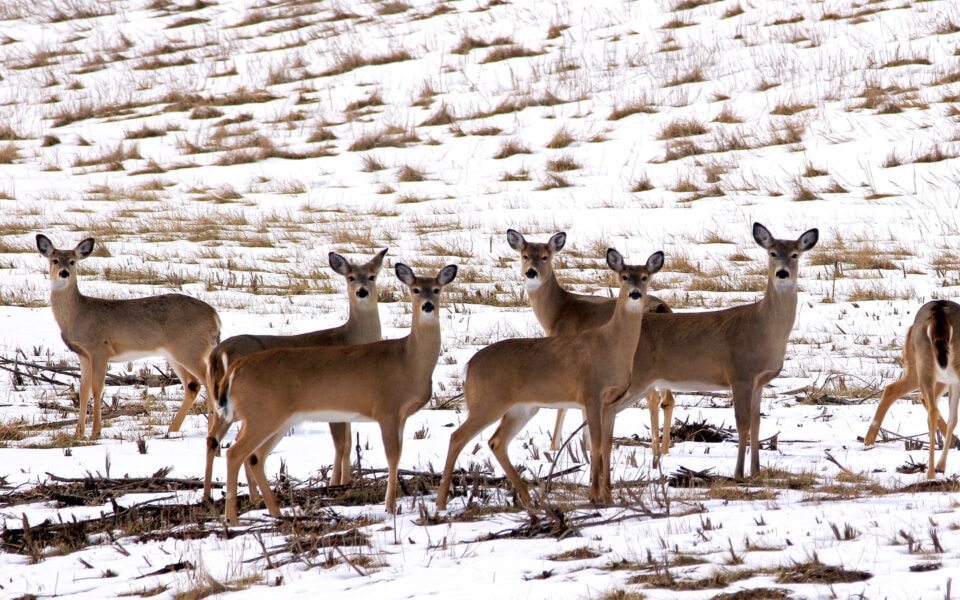“Where are the hare?” my son asked as we bulled our way through a dense copse of jack firs. He was just getting into hunting and I wanted to start him out on small game. It had been more than a decade since I’d directed much effort toward them, but I remembered how abundant the snowshoes were when I first moved into the area, and figured they might provide some positive reinforcement for my young hunter.
It was also a good chance to learn some hunting skills: slipping slowly and quietly along and scanning the underbrush for a beady black eye or a patch of white fur a slightly different shade than the surrounding snow. But try as we might we couldn’t find hide nor hare, not so much as a track or a pile of pellets in the powdery snow. Sensing his frustration, I took the opportunity to explain a little bit about “population cycles.”
Wildlife Population 101
Many wildlife populations experience natural, period fluctuations or cycles, snowshoe hares being one of the classic examples. Like mink and muskrat, goshawks and grouse, lynx and bobcat populations increase along with the abundance of their preferred prey, the snowshoe hare. Hare populations in regions dominated by boreal forest experience dramatic fluctuation cycles lasting around 8-11 years. At their peak, hares may reach a density of up to 1,500 per square mile, more than their habitat can support.
There’s a bit of a lag before predator populations catch up as they benefit from a steady and readily available diet of hare. With increased predation and the onset of starvation, the prey population then starts declining, often rapidly and dramatically. With less available prey, predator populations follow behind. Lower hare numbers allow the habitat to recover and after stabilizing at a lower level for several years, the hare population starts growing and the cycle begins anew. While these classic boom and bust cycles tend to be regular and “density dependent,” they can be exacerbated or ameliorated by non-intrinsic factors like drought or flooding, blight or forest management, over-harvest or wildlife management.
One goal of wildlife management is to keep a population low enough, primarily through hunting, so the “crash level” is not reached. Reducing the impact of this boom and bust cycle reduces widespread die-offs and slow death by starvation while also preventing habitat degradation and waste of the wildlife resource.
Deer Population Management
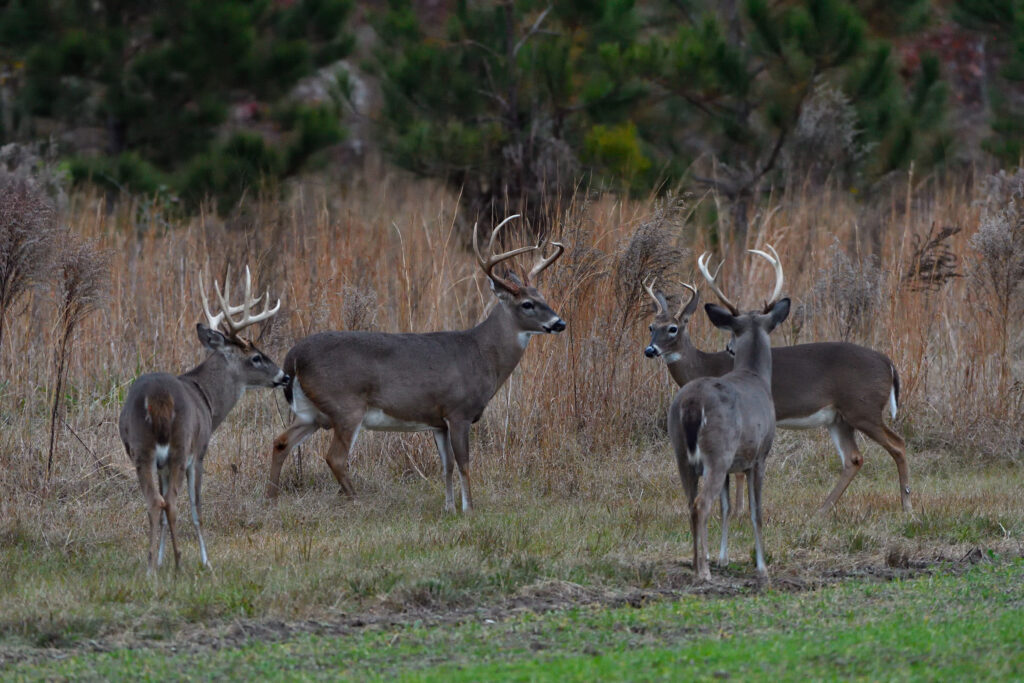
Tes-Jolly
Deer offer a prime example. If left unchecked, deer populations can also experience something of a cycle, or at least a pattern. When a population is below the biological carrying capacity of what the habitat can support, population growth is more rapid. Food is not limited so does are healthier and more productive. As the growing deer herd puts more pressure on the habitat, their health declines. Intra-specific aggression and stress also increase, further reducing fitness. In a perfect world, population growth would level off and the herd would balance itself with available habitat. Scientists describe such a situation as an “S-shaped population growth curve” – a low start then rapid growth followed by a leveling off.
Deer don’t live in a perfect world, and they don’t comprehend overabundance. They’re programmed to produce, so the population overshoots the carrying capacity, sometimes significantly. Habitat becomes degraded to the point where it can no longer support the still-growing deer herd. Without sufficient nutrition, the deer population experiences a mini crash. In time, the habitat recovers, but not as quickly as the deer, so a new, lower carrying capacity is established. Over the long term this develops into a gradual downward trend punctuated with short term boom and bust cycles.
Nature has a way of influencing this pattern. Over-population can also result in outbreaks of disease causing widespread population crashes that better allow the habitat to recover. The aforementioned increase in aggression and stress reduces productivity as does compete for resources and bucks compete for does. Natural disturbances like hurricanes, tornadoes and wildfires initially cause widespread destruction, but can often result in vastly improved habitat in the future.
We can help too, and in doing so, improve the situation dramatically. Holding deer populations at some level below carrying capacity we can prevent the boom and bust cycles and long term decline in population and habitat quality. By removing a certain number of individuals we ensure the rest are healthier and better able to maximize their reproductive potential.
The question then becomes one of how many to remove. The answer depends on where you’re starting and where you want to end up. If you have too many deer, remove a lot. If there are not enough, remove few, if any. If you’re somewhere in between, decide what your ultimate goal is.
Think of your deer herd as an endowment. If you leave the principle in the bank and only take out the interest, you can continue to do so indefinitely. Biologists call this “sustained yield,” and there are different levels. How we derive them involves a complicated set of population dynamics including population size, age and sex ratio, habitat quality and reproductive potential. Suffice to say that through a long history of deer management we’ve figured out how it works.
Quantity vs. Quality
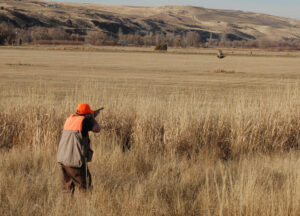
Bob-Humphrey
State deer managers are endlessly trying to referee bouts between hunters who want to see and shoot a lot of deer, and those satisfied with fewer, but bigger bucks. If your goal is to remove the most deer you can in perpetuity – “maximum sustained yield” – you need to maintain your deer herd at around 50 percent of the carrying capacity. It may seem counterintuitive that you need fewer deer on the land to kill more deer, but again, it works, in theory. It often falls short in practice, not because hunters kill too many deer but because they can’t kill enough. First, it’s not easy. Second, deer modify their behavior in response to heavy hunting pressure. Third, people tend to be both skeptical and hesitant about removing large numbers of deer.
A more popular alternative is something called “optimum sustained yield,” which is accomplished by maintaining the population at around 60-70 percent of carrying capacity. You don’t get to remove quite as many deer but you’ll see more. Meanwhile productivity remains high and the habitat doesn’t suffer. It also provides a little buffer should you over-harvest or if there is some type of natural disaster or disease outbreak. If you’re still not happy with the quantity or quality of the deer (and other game) you see and shoot, you can always increase the carrying capacity by improving the habitat and reducing other sources of mortality.
Predator Control
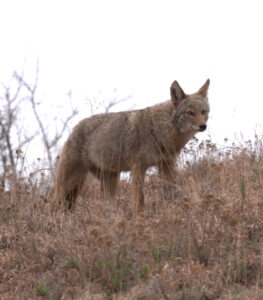 Predator control doesn’t just protect prey; it also protects predators. Outbreaks of diseases like rabies and mange are density dependent to a large extent and spread more quickly when populations are high. This leads to higher predator mortality. When predators become scarce, prey populations increase, sometimes more quickly than we might like – thus more problems and instability are created.
Predator control doesn’t just protect prey; it also protects predators. Outbreaks of diseases like rabies and mange are density dependent to a large extent and spread more quickly when populations are high. This leads to higher predator mortality. When predators become scarce, prey populations increase, sometimes more quickly than we might like – thus more problems and instability are created.
Yet another classic predator-prey cycle that every wildlife student learns about in school involves mink and muskrats. Like lynx and hare, they experience a roughly 10-year cycle with predator populations lagging behind prey by two or three years.
Most land managers probably aren’t too concerned with muskrats, unless they have man-made ponds or impoundments. Muskrats can burrow into pond dams weakening them over time until they eventually fail, leading to massive fish die-offs and removing a potentially important stopover or feeding area for waterfowl. A regular trapping program can prevent or at least significantly delay this from occurring.
Sometimes cycles can be delayed and even eliminated if prey populations become too low while predator densities remain high. Large carnivores like wolves, coyotes and bears prey heavily on deer and moose. They also feed on a variety of other prey like small mammals and so are not as dependent on deer and moose in their diet when those populations are low. However, they still take their fair share, and sometimes more.
When predation remains high but prey populations are low, the latter may reach a point where predation exceeds productivity. Prey species like deer can’t produce enough fawns to out-pace predation so the population cannot increase. Ecologists call this a “predator pit” and the situation may continue or even worsen without some outside influence.
Population Dynamics in Birds
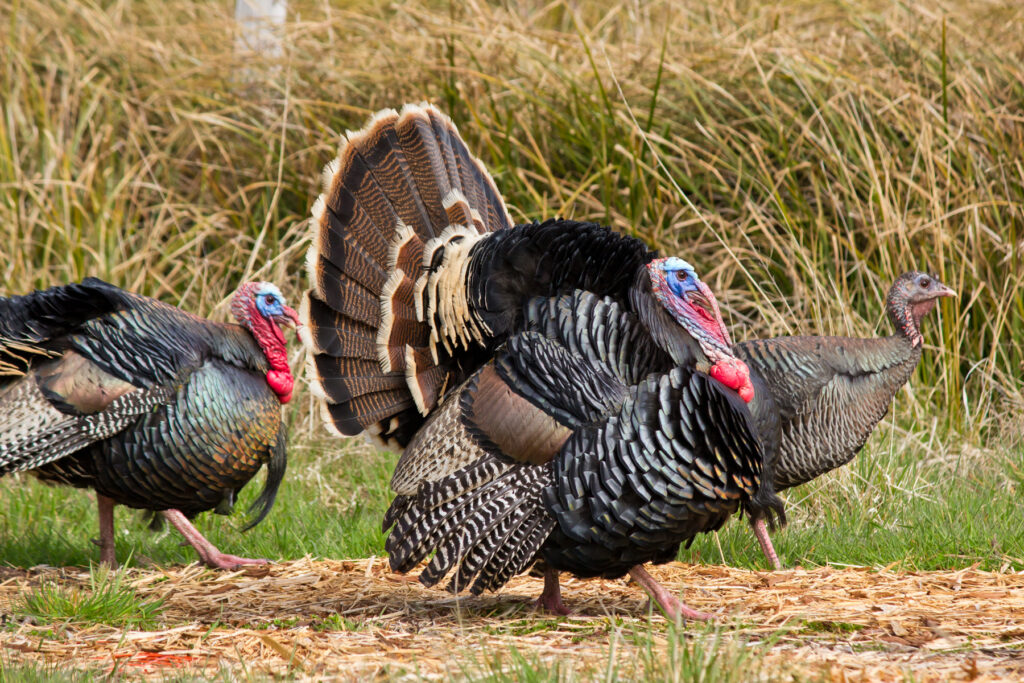
nbiebach
So far we’ve largely addressed mammals but population dynamics and cycles also influence birds and how we might better manage for them. Another classic example is the ruffed grouse. Across much of their northern range, grouse have experienced a rather predictable 10-year boom and bust cycle. The causes are still not fully understood, but not surprisingly involve multiple interacting factors including weather and predation. According to the Ruffed Grouse Society, hunting doesn’t appear to be a factor as it removes only grouse that are in excess of winter carrying capacity. In many areas the grouse’s life cycle is tied in closely with that of poplar trees and maintaining a diversity of age classes on the land can help dampen population declines.
While they’re not necessarily cyclical, turkeys experience occasional declines and seem to be in the midst of one in many parts of the country right now. Part of the cause may be density dependent, as the incidence of diseases like avian pox or LPDV (Lymphoproliferative Disease Virus) increase along with turkey population size. Like any upland bird, they also experience short term declines in years with cold, wet springs, but can usually bounce back in a year or two given better weather. We can help by ensuring they have the right type and variety of habitat to meet different demands throughout the year.
Not a cycle at all, quail populations have been declining for decades. Again, numerous factors are to blame but degradation and loss of habitat are among the biggest. Fortunately, proper habitat management can make a difference, and you’ll find plenty of advice elsewhere among the pages of this magazine.
Conclusion
Mother Nature, at least when viewed through our eyes can seem cruel, but there’s a method to her madness. Boom and bust cycles push plants and animals to their limits and only the strongest survive to reproduce and pass along their genes. While individuals and sometimes populations suffer, species grow stronger. That doesn’t mean that we can’t or shouldn’t lend a helping hand now and then. Keeping populations lower and enhancing habitat benefits both wildlife and the land they live on, and there are always enough other factors to ensure that natural selection keeps weeding out the undesirables.

